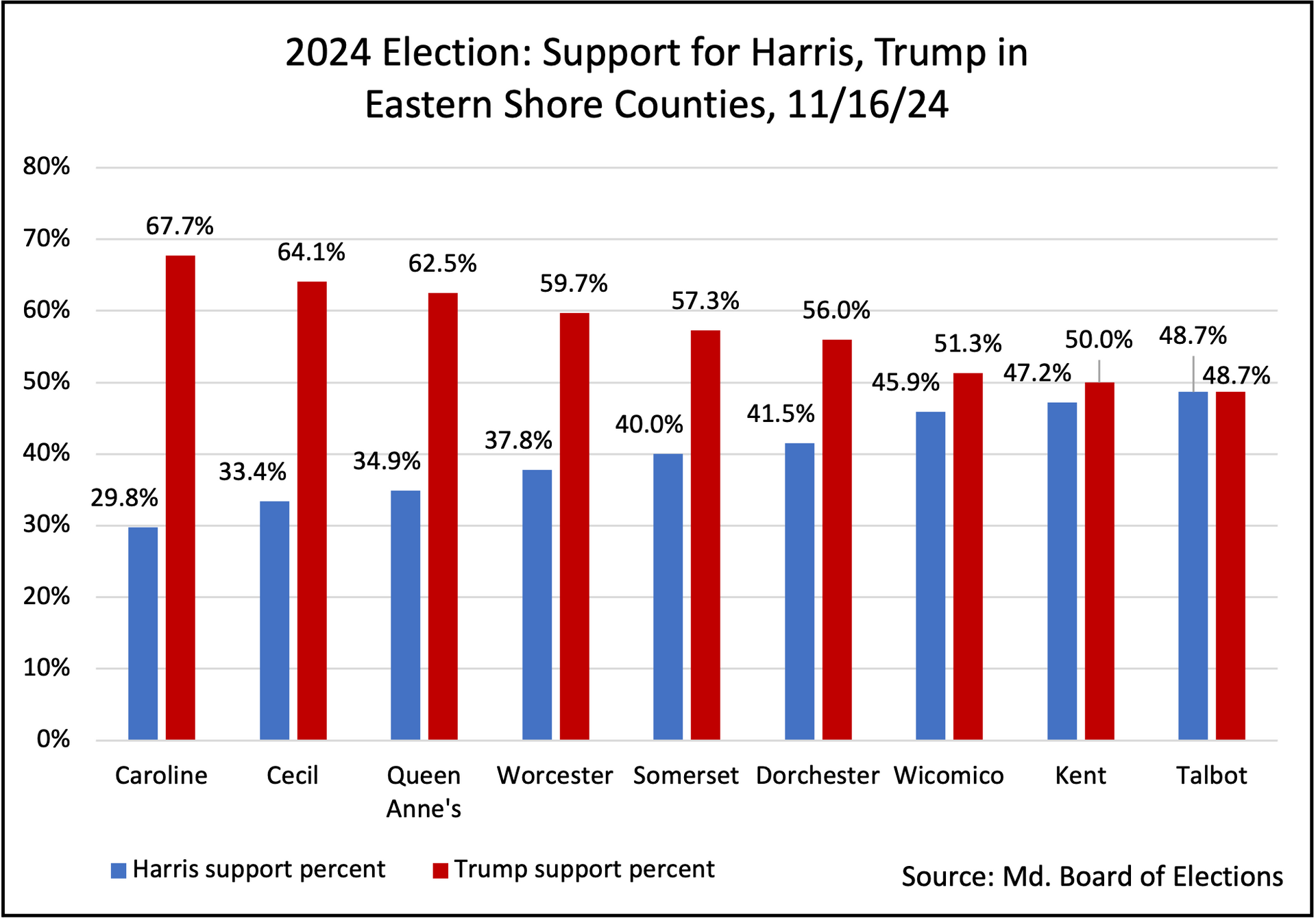No, Mr. Trump, You Have No “Mandate”

The 2024 presidential election was over swiftly. The Associated Press called it at 5:34 am on Nov. 6, and by 8 am, President-elect Donald Trump was crowing about the “historic mandate” given to him by the American people.
A “mandate”? Turns out not.
Trump jumped to an early lead on election night, but in the following days, his lead diminished as mail-in and provisional ballots were counted.
A Baltimore Banner article on Nov. 6 highlighted the “Trump shift” that had occurred in every political subdivision in Maryland, even in counties where Democrat Kamala Harris won. This shift described the increase in Trump support since his loss to President Joe Biden in 2020.
As of Nov. 6, the biggest Trump shift was an 8.1% increase in his support in red Cecil County, but there were also shifts in the central Maryland counties that are the state’s Democratic strongholds — 4.3% in Montgomery and lesser amounts in other blue counties. Fourteen counties recorded shifts of 4% or more. On the Eastern Shore, every county had a shift over 4.5% except Talbot (2.7%), and the five largest shifts were Shore counties. For the state’s Democrats, it did not look encouraging.
But as mail-in and provisional ballots were counted across the state, the Trump shift was reduced everywhere, and as of Nov. 16, disappeared altogether in Garrett (-1.2%) and Charles (-0.1%) counties.
The shift dropped below 3% in all Maryland counties. Cecil’s shift became 2.1%. Montgomery’s shift dropped to 2.9%.
Talbot’s shift declined to 0.2%, lowest of the Eastern Shore counties. Now, instead of five, only two of the highest five shifts were in Eastern Shore counties.
The red bars in the chart below represent the Trump shift percentage values as of Nov. 16, in ascending order.
The grey bars represent the misleading (and ephemeral) Trump shift percentage values as of Nov. 6.
Please note the degree to which the Trump shift lessened and disappeared in the 10 days after the election.
Another red mirage. But if you had only read the Nov. 6 article and not looked at the updated data, you would have been fooled into thinking Trump support is stronger than it is.

That same story is playing out nationally. Trump’s margin looked like a blowout on election night, but as mail-in and provisional ballots were counted, his margin shrank dramatically.
In recent days, Trump’s support has slipped below 50% to 49.96% (76.5 million votes) to Harris’s 48.24% (73.9 million) — a difference of only 1.72%, according to Cook Political Report.
Votes are still being counted and this difference will continue to decrease. The election was very close, as was predicted all along.
Also contradicting Trump’s claim of a mandate is the fact that 93 million eligible voters did not vote — far more than Trump’s share of those who did vote. He was elected with less than one-third of voters choosing him.
So, the majority of eligible U.S. voters did not vote for Trump. And more Americans voted for someone other than Trump.
Hardly a mandate.
Trump’s Electoral College vote count stands at 312, comfortably more than the 270 needed to win. But that doesn’t come close to a mandate compared to these Republican presidents:
- 1972, Nixon, 520 Electoral College votes
- 1980, Reagan, 489
- 1984, Reagan, 525
- 1988, Bush I, 426
Voters in Eastern Shore counties supported Trump, however. Trump received 50% or more of the votes in eight of the nine counties. That support ranged from 67.7% in Caroline County to 50% in Kent County. The only county where Trump did not receive a majority of the vote was Talbot County, where support for Harris and Trump is currently 48.7% each; as of Nov. 16, Trump is ahead by six votes.

Many voters who voted for Trump also supported progressive ballot initiatives across the country. According to the Economic Policy Institute, voters:
- Approved minimum wage increases to $15 per hour in two states (Alaska and Missouri)
- Expanded workers’ ability to earn paid sick leave in three states (Alaska, Missouri, and Nebraska)
- Approved a state constitutional right to abortion in seven states (Arizona, Colorado, Maryland, Missouri, Montana, Nevada, and New York)
- Rejected school vouchers in three states (Colorado, Kentucky, and Nebraska)
- In Alaska, opted to ban anti-union captive audience meetings, while Oregon voters passed a measure to protect cannabis workers’ right to unionize
Maryland was part of this progressive trend.
Question 1 (the ballot initiative to guarantee reproductive rights in the Maryland Constitution) passed with a large majority — 75.7% of Maryland voters voted For Question 1.
On the Eastern Shore, a majority of voters in all counties voted Yes on Question 1, ranging from 57.5% in Caroline to 72.6% in Kent.
Now that’s a mandate!

Jan Plotczyk spent 25 years as a survey and education statistician with the federal government, at the Census Bureau and the National Center for Education Statistics. She retired to Rock Hall.
Common Sense for the Eastern Shore







